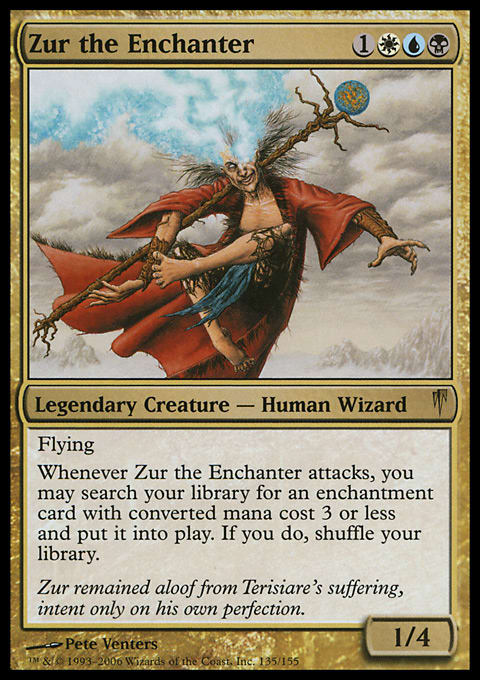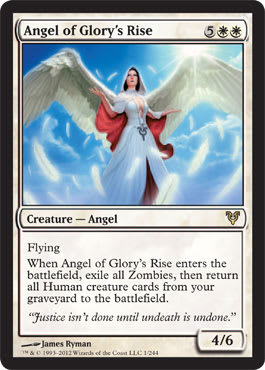After winning another Tuesday-night draft against the best players in the area, the other players there invited me to attend the prerelease late on a Friday night. I happily accepted, looking forward to the challenge of having another format to run roughshod over.
Arriving before the event began, I was startled to see large groups of players at the store that I had never seen before. They seemed . . . different. More than one player would sit with his cards in play in front of him, watching the same person, as if they were all part of the same game. They didn’t display proper in-game posture, choosing instead to laugh uproariously rather than debate specific plays. I leaned in closer to try to learn more about them.
One player had a multicolored creature I did not recognize (which was surprising in itself) with a cornucopia of Auras tiled neatly underneath it. The glamor of the various foils was in stark contrast to their owner’s black t-shirt with faded white text. When he overcommitted further by playing another unnecessary and overpriced enchantment on that same creature and surveyed the board, he saw just one player with any sort of creature in play, and it was far smaller than his over-encumbered monstrosity. He quickly passed without even declaring his combat phase. Seeing a potential teaching moment before me, I attempted to politely inquire as to why he made a line of play that was so plainly (to a player of my caliber) suboptimal. He dismissed my reasoned query with a shrug of his flabby shoulders and a smirking comment about it being “casual.” How anyone could subject a competitive exhibition as well-crafted as Magic to such mockery is beyond me.
When I inquired about this group of players to my well-disciplined network of friends and acquaintances with whom I play, they were somewhat surprised that I hadn’t encountered these sorts of people before (as I take pride in my knowledge of the game’s intricacies). Apparently, these sorts of players—the casual ones—are writing the articles I skip over so instinctively that I never register their presence in the first place. This prerelease, I thought, would be a fascinating expedition into the territory of these sorts of people; apparently, they are drawn to such events where the winner receives nothing but packs. I will play against them and try to learn more about what makes them function (or not function, as I currently see things).
I receive my Sealed pool, and (after a few brief minutes of earnest discussion with the head judge regarding my knowledge of tournament procedure that we should pass our pool off to someone else and register it to prevent fraud, rather than simply opening and relying on those players to be trustworthy and intelligent) look through it. I immediately see that the blue is strong, based on multiple copies of a common that I explain to the people around is better than the rares they covet so much (their arguments against my logic were so flawed that there is no use in summarizing them here), but have to scrape together a playable second color from the trash that this set has provided me. It is encouraging that this set provides so many opportunities for players to misbuild their decks. This will surely be an asset when GP: Vancouver arrives.
My first-round opponent didn’t put up much of a fight, and this was at least partly due to poor play. He attempted to play a soulbond creature, then surveyed the board, thinking about his attack, and then pointed to it and said that it was paired with another creature. Um . . . no? This is a tournament we’re playing, not some little between-rounds make-believe we’re talking about (and even in these practice games, people should be encouraged to practice tight, technical play, or else they will never improve). I sensibly disallowed his blatantly illegal action, even with increasingly pathetic pleas from him afterward. The match was pleasantly quiet after I asserted myself in such a manner. I obviously hold no ill will toward him (I’m sure we all remember what it was like to play in our first tournament), but being at such a young age is certainly no excuse for sloppy game actions.
The second match, though, was much more interesting. My opponent had somehow lucked into a favorable position, in that he had significantly above lethal damage on the board and I possessed neither creatures nor cards in hand. This is when the realization hit me: I would need something more spectacular than the simple flawless play I had used up through this point. I would need to bluff. I would need to use the teachings of the master of Jedi mind tricks himself. I would need to channel Mike Flores.
I was talking with Patrick Chapin about all the decks I’ve made over the years.
If you’ve studied Magic history, you’d know that we—along with other close friends and people inspired by me like Jon Finkel and Kai Budde—have designed DI format-defining decks.
But that’s not the most important thing.
Neither are the articles I’ve written—some of which, like this one, are among the best articles of all time.
Top 5 list, best Magic articles ever by anyone:
- 5. this one, by Yrs Truly
- 4. the one I’ll write next week, by YT
- 3. Tournament Dialogue pt 1, by YT
- 2. Welcome to Magic, by YT
- 1. GP Montreal Postmortem, by YT
Honorable mentions go to other articles published by GM written by YT.
But that’s not the most important thing either.
The most important thing is bluffing. That’s how I won States.
I read a really interesting journal article last week about statistical analysis of people’s self-analysis of how they perform. People often overrate their own competence.
How can we use that?
We can convince them to make the wrong play.
There are many steps to an ultimate goal—whether in life or in Magic—and you can’t skip any.
Our goal is to win the game.
Stop. Go back. Read everything I just wrote again. It will forever change how you look at everything—as it did for Shuhei Nakamura.
Brian Kibler. Jamie Wakefield. “Friggin” Rizzo. PVDDR. Tom Martell. LSV. Chris Pikula.
I’ve talked to those people.
Back to bluffing.
I’m in this prerelease. It’s Round 2.
I’m facing DI damage. Under “normal” thinking, I can’t win here.
But I don’t think that. I can’t think that.
Him: “So, I can . . . attack you here to kill you, right?”
Me: “Can you?”
Him: “What do you mean?”
Me: “Well . . . can you?”
Him: “Um . . . I think so?”
Me: “You think so . . . or do you? Concedetomenow.”
Him: “What did you just say?”
Me: “Nothing. So are you going to . . . not win the game? Concedeconcedeconcede.”
Him: “Um . . . ”
Me: “You’re going to . . . not attack and kill me. I have a knife.”
I won that match 0–1.
The rest of the day wasn’t hard.
There are only a couple people at any tournament who can actually win. I was one of them.
Yes, you might ask yourself, “Doesn’t everyone have a chance to win?”
But look around at them. Are they among the best players in the world?
No. Zero EV.
Are you one of those players?
LOVE
JESSE
Now that I’ve proven my skill with this set, it’s time to turn to something almost as important as winning games: design. While there are certainly a few “designers” within Wizards who have proven to have a small amount of competence at the game, their decision-making regarding this and other sets has been questionable at best; anyone within the company who disagrees is welcome to challenge me to a match so that I may prove my expertise in these areas far outweighs theirs.
While I will be happy to have a sustained and intelligent debate regarding recent changes to the game, I am sure that any reasonable person who studies the issues closely will agree with me that Wizards has ruined everything and they should all be fired at once.
Any review must look at the broader impacts of a set, seeing beyond the minutiae of individual cards to reach the hidden artistry contained within it. Unfortunately, Avacyn Restored is an altogether artless blunt object beating sensible and refined players about the head, so we will start with the first card by collector number:
This card is an absolute waste of space, as I cannot find any application for it in a single existing deck in any format that matters to me (currently Legacy and Modern). I cannot think of what possible thought process these hacks must have had that led them to price a 4/6 at 7; I suspect that it was instead a lack of thought that led to such a useless collection of ink and paper occupying a scarce rare slot. The text is something regarding the supposedly flavorful interactions of humans and zombies, though it would be a dishonesty to the reader if I did not confess to forget exactly what the ability does (though it is readily apparent that it accomplishes next to nothing). We, as players, must take a stand against these utterly useless cards.
It is possible that the card was designed as some sort of “skill tester” as a means of tricking worse players into using it, thus granting the more experienced and dedicated an even larger advantage, but I highly doubt that the acquisition-oriented glorified accountants who run R&D could think that far ahead. Even if they wanted to create such a thing, the card is simply not interesting enough to create the sort of skill-intensive Magic we used to have. For example, here is one of my designs that, while not among my best works, I feel illustrates the sort of skill test the game could use in place of another big, useless creature:
|
Angel of Flagellation Rare
Creature – Angel At the beginning of each phase, any other player may choose to tap Angel of Flagellation. If no player does, untap it.
3/4
|
By creating another in-game dynamic that players have to compete over, Magic gets a whole new dimension of ways to outplay one’s opponent. (This mechanic was featured heavily in my design profile I sent to Wizards in response to one of their job postings; one assumes they required yet another yes-man to continue the downward spiral on which Magic continues). Perhaps this public “spoiler,” so to speak, will increase public pressure and result in my hiring there.
However, I have been advised that players are no longer interested in set reviews that simply tackle the design (as players have been the ducks force-fed the homogenized corn of Mark Rosewater design “insight” for the purpose of creating the foie gras of [rest of metaphor TK]), I will also address the art, which prominently features a gloriously highlighted pair of proud female features. I applaud Wizards for this brave anti-misandry stance, and I will end on this high note so that people understand I can find common ground with the employees of that company despite their numerous failings and faults.
Jesse Mason


























